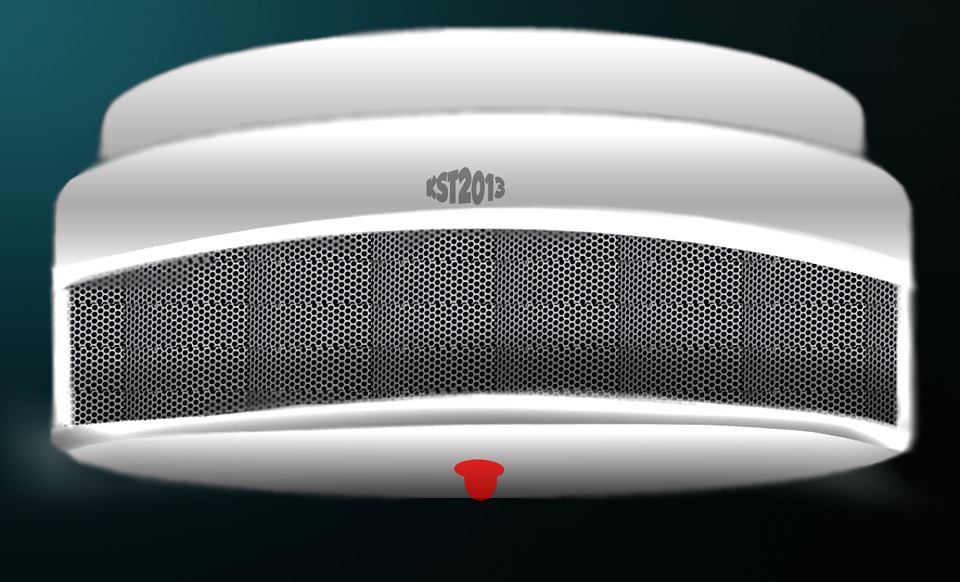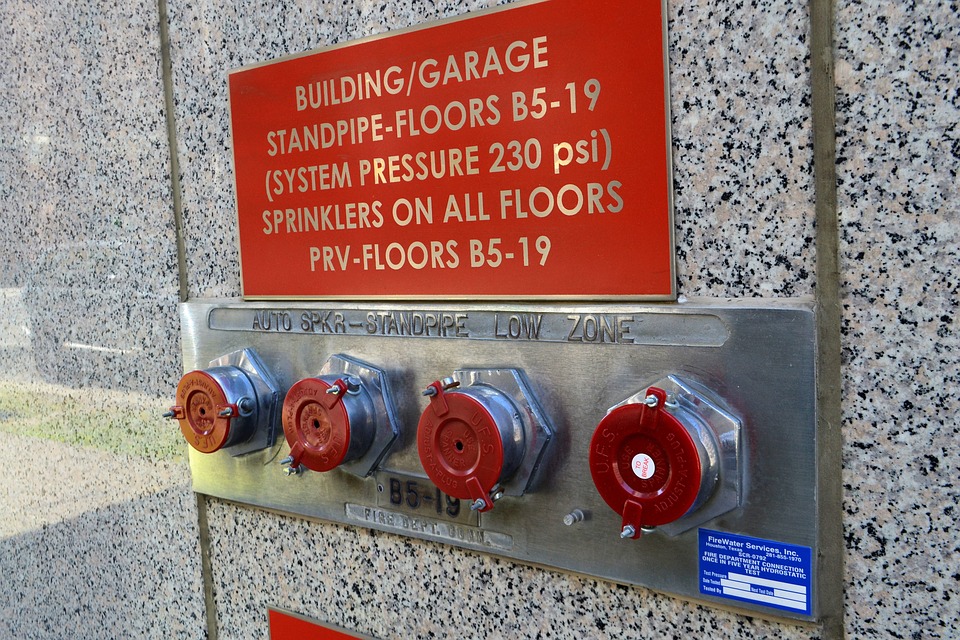Your commercial establishment relies on fire protection to guard against destructive and deadly fire. If a fire were to break out, you risk everything you have worked so hard for going up in smoke. Not only should you ensure that your fire protection system is properly installed, but you should maintain each component of your system on a regular basis.
The basic components of commercial fire protection ensure that fire is snuffed before it can become a danger. The system is made to sniff out fire and alert people nearby. Some components activate on their own to extinguish the fire while others must be activated manually from a designated fire station. Other components make quick work for any smoke that may linger after a fire has been extinguished, and then there are the systems that firefighters use to communicate when a fire has demolished the building’s electric capabilities.
All of these components work like the instruments of an orchestra, and the crescendo is the fire alarm and sprinkler activation that saves your business when fire breaks out.
If even one of those components is out of whack or defective in any way, you could have a fire on your hands that rages out of control, putting your business in jeopardy.
Keep fire at bay, and each aspect of your fire system fully operational by using the following checklist. Here are the basic components of most fire protection systems. Learn about them and keep the components maintained for the total protection of your business and the safety of your staff and customers.
Alarm Initiation: These devices inform the fire safety system that an incident is underway. The purpose of the system is to alert emergency personnel and to allow safeguards to begin. The system can be manual or automatic. The manual aspect of the system is controlled by way of alarm buttons and pull stations that people can activate. The alarms and pull-action devices are strategically located at every exit, and each fire system component is clearly marked for ease of use. The automatic aspect of the system can be activated by way of heat, flame, and CO2 detectors. Some advanced systems use photoelectric, ionization, and in-duct smoke detectors for even more accurate fire detection.
Alarm Notification: This fire prevention system informs people when all is safe, when an event is underway, and when a maintenance issue is needed. The system can be set up to alert people on-site and those located elsewhere. Examples of remote individuals who may be notified include emergency responders and police. The alarm can take the form of noise, like bells, chimes, horns, and voice evacuation, or light in the form of strobes. In some cases, horn-strobes will deliver a combination of sound and light. The alarm notification system itself is usually housed in weatherproof and hazard-proof housing to ensure it works when needed at all costs.
Fire Alarm Control Panel (FACP): The FACP is the central brain of the commercial fire protection system. The panel manages all of the devices and sends signals back and forth. If an issue is detected, the control panel will notify the necessary parties to bring about swift maintenance action. The control panel usually contains branch-circuit wiring and replaceable circuit cards for ease of maintenance and repair. Newer systems have digital circuits that transmit data to all devices, and that can be programmed for specific zones. Every panel has a display that showcases the system’s status along with troubleshooting codes and a touchpad for programming and system management. Using the touchpad, a user can disable the alarm, signal alerts, reset the fire protection system, and reprogram the system entirely.
Backup Power Supply: A commercial operation should have a working fire system even when the main power supply goes down. In cases of a power outage, all commercial fire protection systems have UL listed emergency batteries contained in sealed units. These batteries are designed to prevent disruption to the fire protection alert system in the event of a catastrophe. The battery housing may be located in the control panel itself or in a separate enclosure mounted next to the fire alarm control panel
Remote Control and Display Panels: These fire safety components allow the entire system to be checked, and the alarms to be initiated or silenced. Other components can be activated or deactivated, even if the components are located off-site. Remote control and display panels are typically reserved for larger systems, such as the ones installed in high-rises and where local codes state that fire alarm system must be able to be remotely controlled from an area other than the primary FACP.
Sprinkler Systems: Automatic fire sprinklers are added to most commercial buildings to respond to fire without the need for human intervention. The components are installed and positioned so that they emerge from the ceiling. When heat is detected, the sprinklers activate, dousing the fire until it is properly extinguished. A common myth persists that heat causes every sprinkler head to activate. While this belief probably exists because of the movies, in truth, the sprinklers will only activate when direct heat is detected by a particular sprinkler head. This allows the system to concentrate the extinguishing agent at the fire instead of causing collateral water or chemical damage.
There are several types of fire sprinklers. There are wet pipe and dry sprinklers. Wet sprinklers are the most common and are relatively low maintenance. Dry sprinklers make use of pressurized air which exits before the water escapes. Then there are pre-action sprinklers, which are filled with air and water and are activated when the smoke alarm or fire detector goes off. These latter systems are used in areas where the expulsion of water would cause too much damage, like at warehouses and industrial plants.
For commercial operations that want all sprinklers activated at once in case of fire, better known as deluge sprinkler systems, these can be installed at a higher cost. The system features open nozzles and is commonly found in industrial parks that need quick action with regards to the presence of one or more flammable liquids.
Standpipes: A standpipe delivers water from a primary source to hose connections in key locations throughout a large building. Firefighters rely on these connections to fight fires on various floors of a high rise, for example. The systems can be automatic, manual, wet or dry, and are normally filled with pressurized air so that the extinguishing agent can be used to douse any fire to completion.
Smoke Control Systems: Some commercial fire protection systems use smoke control devices, which work to limit the spread of smoke throughout the building. Smoke control is necessary, as smoke damage can be costly for all commercial operations. By utilizing fans, dampers, doors, and shutters that all work in harmony to isolate and contain the spread of smoke, businesses can save thousands in renovation and cleaning costs in the case of a dangerous fire.
Fire Command Systems: Many buildings use a fire command system to evaluate, maintain, and communicate during a fire event. The fire protection component also provides real-time updates and is used by emergency services to communicate and comprehend the various situations that may be outside of fire control.
Post-Fire Smoke Purge: This fire prevention component is similar to the smoke control system. Using a series of fans and shutters, the component eliminates smoke from permeating inside the building. Many post-fire systems include automatic ventilation from windows and doors so that the smoke can be flushed from the building, preventing further costly damage. Even after the fire has been extinguished, the post-fire smoke purge system will continue to evict smoke from the building, making it fit once again for occupancy.

Auxiliary Radio Communication Systems (ARCS): The ARCS provides reliable communication for firefighters who may be separated by smoke and thick walls. The system is installed within the building and include a base station, radio consoles, an antenna, radiating cables, and power supplies. There are two distinct features to the ARCS: the system needs to be wireless and bidirectional. The system also must operate continually, even during power outages. This constant functionality allows firefighters on the scene to communicate effectively, even if the fire has damaged the building’s electrical system.
Are Your Fire Protection Components Properly Maintained?
As you can see, there are a lot of moving parts to the average commercial fire protection system. Each component works with all the others to provide a comprehensive approach to fire safety. From detecting fire and going into action with the necessary extinguishers to the continual purging of smoke even after the fire has been put out, all of these components need to work exactly as intended.
If even one fire safety component is malfunctioning, you could be putting lives and your business at risk.
What Happens if Even One Fire Protection Component Goes Kaput?
Imagine a fire breaks out in your commercial business, only your staff is never notified because the alarm initiation system failed to activate. With no notification, your staff would resume business as usual until the smoke and soot becomes too thick to breathe. Your customers would be alerted and may begin to evacuate. By that point, the damage may already be too great.
Smoke could damage your walls, floors, and all your furnishings and equipment. Your staff could inhale smoke, leading to breathing problems and worker’s compensation claims. The fire could damage your business, leading to costly renovation and cleaning costs, not to mention all the weeks and months you stand to lose by keeping your business closed until the fire damage can be maintained.
With so much at risk, you owe it to yourself to get the proper maintenance for your fire protection equipment, even if it appears that the system is working properly. The control panel may say all is well, but only a thorough assessment by professionals can give you the proper green light that your components are working properly.
While a single fire could see your commercial operation shut down for the long-term, a faulty fire protection component could also cost you in fines from the local Fire Marshall. If your commercial business is lacking in fire detection, alarms and notification, and fire suppression, you could face fines and the mandate that you shut down until those components are fixed, replaced, or properly installed.
To ensure the proper symbiosis of your commercial fire protection components, it is best to involve the services of experienced fire suppression experts.
Call Now for a Free Estimate on All Fire Protection Component Repairs & Replacements
Don’t take the chance that your fire detection, protection, and suppression equipment are working as they should. Instead, call Nationwide Fire Protection corp. We offer premium fire protection installation, maintenance, and repair to customers throughout the areas of Denver, Colorado.
We can ensure your system is primed to detect the presence of fire and act quickly, no matter what. With a system that is working with all components intact, you can effectively minimize damage to your building and protect your customers and staff in the unfortunate chance of fire.
You can save time and money by working with professionals like our technicians at NFP. We work directly with the manufacturers to bring you the best parts and equipment in the industry. When you think of fire protection, always think of Nationwide Fire Protection corp. We have your best interests in mind and want to help you keep the risk of fire as low as possible. Whether you need service or repairs, we can keep your business safe from fire, guaranteed. Call now for a free quote on all commercial fire protection components.

